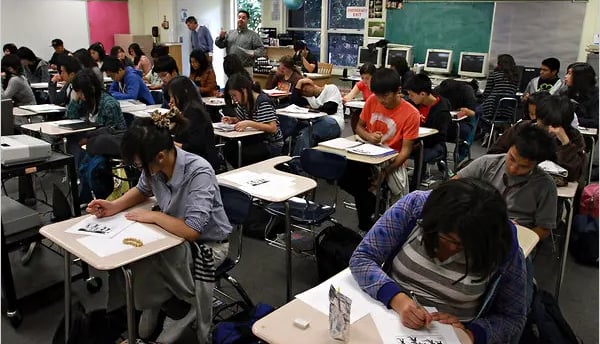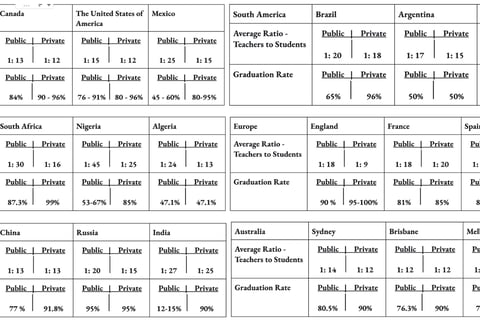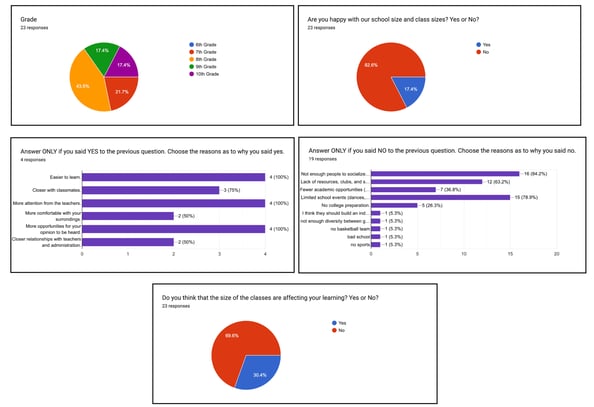Class Sizes in High School
OPINIONINFORMATIVEFEATUREDSHANNA S.
Shanna S.
4/3/202511 min read


Personal Experience
When I lived in Canada, I attended a private school that had two classes per grade with 18 to 22 students in each class. As I attempted to learn, I found it difficult to focus because of the larger number of students in my class. Since most students weren’t interested in doing the same, they chose to act out; this included engaging in multiple side conversations, playing with toys, and drawing on notebooks. Unfortunately, these actions distracted me from the teacher’s lesson; therefore, my understanding of the subject was compromised. However, I managed to deal with the misbehaving students for the 6 years I was at the school and I feel as though I had obtained the necessary amount of comprehension, despite that I found learning was more challenging.
Throughout my time in Centner Academy, I realized how much of a difference class sizes can make. All of the classes I have been in had around 12 to 15 students, which is lower than what I grew up with. I found that this slight change in the amount of students in the class shifted my learning ability in a positive way. Instead of teachers focusing on students who are disturbing the class, like my teachers from Canada, teachers gave their attention to the students who were wanting to learn. The increased focus on the listening students and I helped my mind grasp topics that would be difficult to understand with interference from other students.
However, when my learning capacity expanded, my social life declined. The smaller number of students means that there are less chances of friends to acquire. Unlike a large school, there are multiple friend groups to choose from and if you happen to not like the students you are with in a class, you can switch the class to be with peers more suitable to your liking.
Purpose
Since schools have different teacher-student ratios, I am interested in comparing the learning environment of schools with different class sizes, a smaller number of students compared to a larger number of students. In addition, I am interested in learning if the ratio affects the students' feelings in the school or solely academic performance. To help answer my questions, I decided to research the graduation rate of all continents, their common countries, and popular cities depending on the teacher-student ratio in public schools versus private schools to find the different levels of learning abilities. Furthermore, for a more personal perspective, I conducted a survey for my peers in my school on the impact of a smaller school and how it affects them personally.
History
The first known records of schools were from ancient civilizations, even dating back over 5000 years ago. The learning environment varied for each civilization, often taking place in a temple, home, or public space rather than a formal school. Teachers, mentors, or tutors of ancient civilizations taught very few students, even only one or two. Class sizes were small since education was considered only for the wealthy or high ranking citizens. Nonetheless, students had more guided attention from their teacher, allowing them to engage more deeply in the material which showed their family the hard work the student was putting forth for them.
Research
Interpreting the Research
From these teacher-student ratios in either public or private schools as well as their respective graduation rates, I understand that private schools either have a smaller number of students or around the same number of students compared to public schools. I can also conclude that the graduation rate of private schools is larger than the rate of public schools due to the fact that there are less students in those schools. Even if students don’t put effort into learning, fewer students in a class allow the teacher to teach students that aren’t paying attention without the students even realizing they understand the lesson. This is because there aren’t any distractions to keep the students mind occupied from the lesson, so if a student wants to ignore the teacher and stare at the wall, they will still hear and understand the teacher with or without their desire to learn.
Data
Analyzing Data
From the survey I conducted on middle school and high school students, 5 seventh graders, 10 eighth graders, 4 ninth graders, and 4 tenth graders responded by providing information to explain their feelings for the small school we are learning in. Out of those 23 students, 17.4% (4 students) answered that they are happy with the school size and class size. Meanwhile, 82.6% of those 23 students (19 students) answered that they are unhappy with the school size and class size.
All of the four students believe that they are happy with the school size and class sizes because they find it easier to learn, they gain more attention from the teachers, and they find that there are more opportunities for their opinions to be heard. Three out of the four students believe that the small school size brings them closer to their classmates and peers. Two out of the four students find that they are more comfortable with their surroundings because of the smaller environment. Another two out of four students believe that they are able to build closer relationships with teachers and the administration in the school.
In contrast to the four students who are happy, sixteen out of the nineteen students are unhappy with the school size and class sizes because there are not enough people to socialize with. Fifteen out of the nineteen students find that the lack of school events like dances, pep railles, and football games are a downside of a smaller school. Twelve out of the nineteen students believe that the lack of resources, clubs, and specialized activities feed into their negative feelings for a small school. Seven out of the nineteen students find that there are fewer academic opportunities like honors, AP, and Cambridge AICE courses in the school. In addition, five out of the nineteen students find that there is a minimal amount of college preparation or even none at all.
69.6% of the 23 students (16 students) believe that the size of the class doesn’t affect their learning ability. However, 30.4% of the students (7 students) find that the size of the class does affect their learning ability. Some positive remarks from the students who perceive their learning in a positive way are, “...there are less distractions and it is easier for the teacher to teach,” “I get personal attention from the teacher allowing me to learn better,” “...does give us the opportunity to get more one on one learning time with our teachers,” and, “...less chaotic classrooms…”
Some negative remarks from the students who perceive their learning is compromised from the small class size are, “...because of the small class size, it is hard to get along with the small amount of people in this class, so group learning is almost impossible…” and, “...the small class size limits the options for group projects or certain assignments.”
Importance
In conclusion, small school sizes and large school sizes have their pros and cons. Small school sizes have benefits such as more attention from and connections with teachers, closer relationships with classmates, easier learning, and comfort in the school environment. However, there are negatives to a small class size, such a lack of people to socialize with, lack of afterschool activities and resources, fewer academic opportunities, limited school events, and minimal college preparation. Larger schools have more students to socialize with but more students means more distractions, making learning more difficult. In addition, larger schools have more opportunities such as school events, academic levels, clubs, and extracurricular activities. Understanding the positives and negatives of both a smaller and larger school can help a student decide what school is a better fit for them and which school will help them succeed in their life.






Personal Experience
When I lived in Canada, I attended a private school that had two classes per grade with 18 to 22 students in each class. As I attempted to learn, I found it difficult to focus because of the larger number of students in my class. Since most students weren’t interested in doing the same, they chose to act out; this included engaging in multiple side conversations, playing with toys, and drawing on notebooks. Unfortunately, these actions distracted me from the teacher’s lesson; therefore, my understanding of the subject was compromised. However, I managed to deal with the misbehaving students for the 6 years I was at the school and I feel as though I had obtained the necessary amount of comprehension, despite that I found learning was more challenging.
Throughout my time in Centner Academy, I realized how much of a difference class sizes can make. All of the classes I have been in had around 12 to 15 students, which is lower than what I grew up with. I found that this slight change in the amount of students in the class shifted my learning ability in a positive way. Instead of teachers focusing on students who are disturbing the class, like my teachers from Canada, teachers gave their attention to the students who were wanting to learn. The increased focus on the listening students and I helped my mind grasp topics that would be difficult to understand with interference from other students.
However, when my learning capacity expanded, my social life declined. The smaller number of students means that there are less chances of friends to acquire. Unlike a large school, there are multiple friend groups to choose from and if you happen to not like the students you are with in a class, you can switch the class to be with peers more suitable to your liking.
Purpose
Since schools have different teacher-student ratios, I am interested in comparing the learning environment of schools with different class sizes, a smaller number of students compared to a larger number of students. In addition, I am interested in learning if the ratio affects the students' feelings in the school or solely academic performance. To help answer my questions, I decided to research the graduation rate of all continents, their common countries, and popular cities depending on the teacher-student ratio in public schools versus private schools to find the different levels of learning abilities. Furthermore, for a more personal perspective, I conducted a survey for my peers in my school on the impact of a smaller school and how it affects them personally.
History
The first known records of schools were from ancient civilizations, even dating back over 5000 years ago. The learning environment varied for each civilization, often taking place in a temple, home, or public space rather than a formal school. Teachers, mentors, or tutors of ancient civilizations taught very few students, even only one or two. Class sizes were small since education was considered only for the wealthy or high ranking citizens. Nonetheless, students had more guided attention from their teacher, allowing them to engage more deeply in the material which showed their family the hard work the student was putting forth for them.
Research
Interpreting the Research
From these teacher-student ratios in either public or private schools as well as their respective graduation rates, I understand that private schools either have a smaller number of students or around the same number of students compared to public schools. I can also conclude that the graduation rate of private schools is larger than the rate of public schools due to the fact that there are less students in those schools. Even if students don’t put effort into learning, fewer students in a class allow the teacher to teach students that aren’t paying attention without the students even realizing they understand the lesson. This is because there aren’t any distractions to keep the students mind occupied from the lesson, so if a student wants to ignore the teacher and stare at the wall, they will still hear and understand the teacher with or without their desire to learn.
Data
Analyzing Data
From the survey I conducted on middle school and high school students, 5 seventh graders, 10 eighth graders, 4 ninth graders, and 4 tenth graders responded by providing information to explain their feelings for the small school we are learning in. Out of those 23 students, 17.4% (4 students) answered that they are happy with the school size and class size. Meanwhile, 82.6% of those 23 students (19 students) answered that they are unhappy with the school size and class size.
All of the four students believe that they are happy with the school size and class sizes because they find it easier to learn, they gain more attention from the teachers, and they find that there are more opportunities for their opinions to be heard. Three out of the four students believe that the small school size brings them closer to their classmates and peers. Two out of the four students find that they are more comfortable with their surroundings because of the smaller environment. Another two out of four students believe that they are able to build closer relationships with teachers and the administration in the school.
In contrast to the four students who are happy, sixteen out of the nineteen students are unhappy with the school size and class sizes because there are not enough people to socialize with. Fifteen out of the nineteen students find that the lack of school events like dances, pep railles, and football games are a downside of a smaller school. Twelve out of the nineteen students believe that the lack of resources, clubs, and specialized activities feed into their negative feelings for a small school. Seven out of the nineteen students find that there are fewer academic opportunities like honors, AP, and Cambridge AICE courses in the school. In addition, five out of the nineteen students find that there is a minimal amount of college preparation or even none at all.
69.6% of the 23 students (16 students) believe that the size of the class doesn’t affect their learning ability. However, 30.4% of the students (7 students) find that the size of the class does affect their learning ability. Some positive remarks from the students who perceive their learning in a positive way are, “...there are less distractions and it is easier for the teacher to teach,” “I get personal attention from the teacher allowing me to learn better,” “...does give us the opportunity to get more one on one learning time with our teachers,” and, “...less chaotic classrooms…”
Some negative remarks from the students who perceive their learning is compromised from the small class size are, “...because of the small class size, it is hard to get along with the small amount of people in this class, so group learning is almost impossible…” and, “...the small class size limits the options for group projects or certain assignments.”
Importance
In conclusion, small school sizes and large school sizes have their pros and cons. Small school sizes have benefits such as more attention from and connections with teachers, closer relationships with classmates, easier learning, and comfort in the school environment. However, there are negatives to a small class size, such a lack of people to socialize with, lack of afterschool activities and resources, fewer academic opportunities, limited school events, and minimal college preparation. Larger schools have more students to socialize with but more students means more distractions, making learning more difficult. In addition, larger schools have more opportunities such as school events, academic levels, clubs, and extracurricular activities. Understanding the positives and negatives of both a smaller and larger school can help a student decide what school is a better fit for them and which school will help them succeed in their life.




Interested? Find more by Shanna here!
ABOUT SHANNA
Shanna is a 9th-grader taking her first journalism class at Centner Academy. She is responsible for writing captions and brief introductions for articles, as well as designing the physical copy of the Pollinator Post. Shanna is passionate about writing reviews and conducting interviews. Outside of journalism, Shanna also enjoys ballet.
Engage
Empowering students to share their stories and news.
Connect
thepollinatorpost@gmail.com
© 2024. All rights reserved.